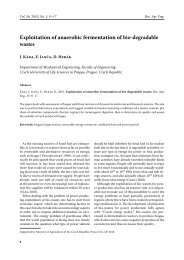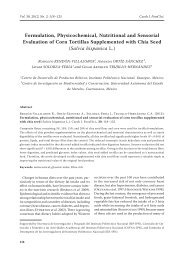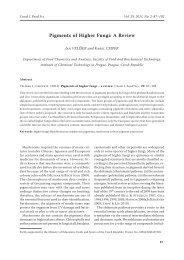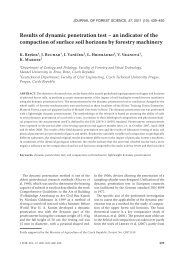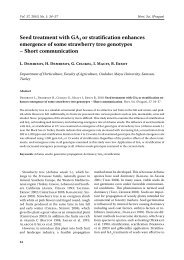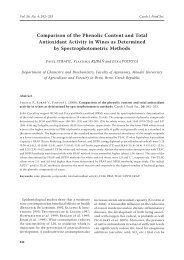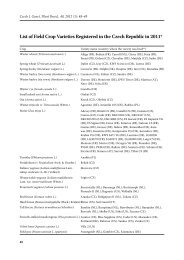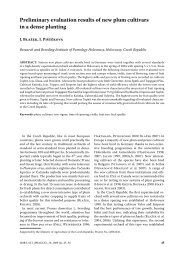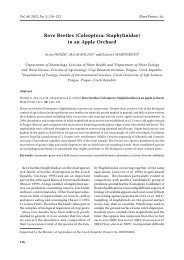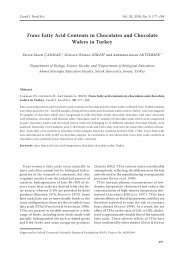The Viral Etiology of Tomato Yellow Leaf Curl Disease – A Review
The Viral Etiology of Tomato Yellow Leaf Curl Disease – A Review
The Viral Etiology of Tomato Yellow Leaf Curl Disease – A Review
Create successful ePaper yourself
Turn your PDF publications into a flip-book with our unique Google optimized e-Paper software.
Plant Protect. Sci. Vol. 45, 2009, No. 3: 81<strong>–</strong>97<br />
gene with an inverted-repeat construct (Zrachya<br />
et al. 2007b).<br />
8.3. Physical and chemical measures<br />
In the last two decades, there has been a worldwide<br />
spread <strong>of</strong> the B biotype <strong>of</strong> B. tabaci, the only<br />
known vector <strong>of</strong> TYLCV. Among measures taken to<br />
minimise the damage, vector control by pesticides<br />
and physical barriers is commonly used, especially<br />
in countries for which the more resistant hybrid<br />
varieties are too expensive. Conventional chemical<br />
control <strong>of</strong> the whitefly is difficult to achieve<br />
because <strong>of</strong> the distribution <strong>of</strong> its immature forms,<br />
primarily on the underside <strong>of</strong> leaves, with older<br />
larvae and pupae located lower in the plant canopy.<br />
<strong>The</strong> diversity <strong>of</strong> cultivated and weed host plants<br />
attacked contributes to the source <strong>of</strong> infestation. A<br />
number <strong>of</strong> insecticides have effectively controlled<br />
this pest in the past but resistance develops rapidly.<br />
Several new materials, including insect-growth<br />
regulators and new pyrethroid insecticides, appear<br />
promising. However, the resistance phenomenon<br />
suggests that their efficacy will also be <strong>of</strong> limited<br />
duration. Thus, the current reliance on chemical<br />
control must be considered a temporary measure,<br />
pending the development <strong>of</strong> a satisfactory integrated<br />
pest management program.<br />
At the moment, growers use a variety <strong>of</strong> chemicals<br />
to combat the whitefly: acephate, bupr<strong>of</strong>ezin,<br />
cyfluthrin, deltamethrin, imidacloprid, permethrin<br />
and pirimiphos methyl are the active substances in<br />
the most popular products. Chemicals are used in<br />
both protected and unprotected cultivation (Attard<br />
2002). Physical control is usually achieved<br />
by using a very fine net to stop the adult whiteflies<br />
from reaching the tomato plants. This is used<br />
on protected cultivations, as well as in the open<br />
field. <strong>Yellow</strong> traps are also used in glasshouses,<br />
in the form <strong>of</strong> sticky yellow plastic cards hung at<br />
several intervals along the rows <strong>of</strong> tomato plants.<br />
<strong>The</strong> use <strong>of</strong> photoselective plastic covers that block<br />
ultraviolet (UV) light has been proposed as a good<br />
method <strong>of</strong> controlling TYLCD because it interferes<br />
with the whitefly’s vision, resulting in an over 50%<br />
reduction in disease incidence.<br />
9. Concluding remarks<br />
Our understanding <strong>of</strong> the life cycle <strong>of</strong> TYLCV<br />
has increased considerably in recent years. Never-<br />
theless, many unanswered questions remain with<br />
respect to its biology and epidemiology, and the<br />
disease it causes appears to be spreading on a global<br />
scale. Although much work has been invested<br />
in the development <strong>of</strong> TYLCV-resistant tomato<br />
lines, effective and durable resistance to TYLCV<br />
remains elusive. With the new “genetic engineering”<br />
technologies, the introduction <strong>of</strong> novel genetic<br />
traits, from the pathogen itself and/or from other<br />
sources, should be considered in the battle against<br />
the disease. Today’s challenge, then, is to gain a<br />
better understanding <strong>of</strong> the functions <strong>of</strong> the viral<br />
genes and their gene products, as well as <strong>of</strong> their<br />
interactions among themselves and with the host<br />
cell. In the fight against TYLCV, such knowledge<br />
is rapidly becoming a necessity.<br />
Acknowledgements. <strong>The</strong> authors apologise to colleagues<br />
whose original works were not cited due to lack <strong>of</strong> space.<br />
We would like to thank Katharina Kittelmann for providing<br />
us the electron microscopy image <strong>of</strong> geminiviruses<br />
and for critical reading <strong>of</strong> the manuscript. We gratefully<br />
thank the Israeli Science Foundation (ISF), the US-Israel<br />
Binational Research and Development Fund (BARD) and<br />
the US-Israel Binational Science Foundation (BSF) for<br />
supporting the research described herein which was performed<br />
in our laboratory. This paper is contribution No.<br />
140/2009 from the Agricultural Research Organization,<br />
the Volcani Center, Bet Dagan, Israel.<br />
References<br />
Abhary M.K., Anfoka G.H., Nakhla M.K., Maxwell<br />
D.P. (2006): Post-transcriptional gene silencing in<br />
controlling viruses <strong>of</strong> the <strong>Tomato</strong> yellow leaf curl virus<br />
complex. Archives <strong>of</strong> Virology, 151: 2349<strong>–</strong>2363.<br />
Accotto G.P., Bragaloni M., Luison D., Davino S.,<br />
Davino M. (2003): First report <strong>of</strong> tomato yellow leaf<br />
curl virus (TYLCV) in Italy. Plant Pathology, 52: 799.<br />
Akad F., Jacobi J.C., Polston J.E. (2007): Identification<br />
<strong>of</strong> <strong>Tomato</strong> yellow leaf curl virus and <strong>Tomato</strong> mottle<br />
virus in two counties in Alabama. Plant <strong>Disease</strong>, 91:<br />
906<strong>–</strong>906.<br />
Antignus Y., Vunsh R., Lachman O., Pearlsman<br />
M., Maslenin L., Hananya U., Rosner A. (2004):<br />
Trucated Rep gene originated from <strong>Tomato</strong> yellow<br />
leaf curl virus israel [Mild] confers strain-specific<br />
resistance in transgenic tomato. Annals <strong>of</strong> Applied<br />
Biology, 144: 39<strong>–</strong>44.<br />
Ascencio-Ibanez J.T., Diaz-Plaza R., Mendez-Lozano<br />
J., Monsalve-Fonnegra Z.I., Arguello-As-<br />
91




